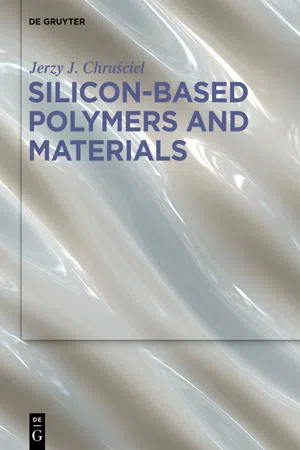
Silicon-Based Polymers and Materials
- 428 pages
- English
- ePUB (mobile friendly)
- Available on iOS & Android
Silicon-Based Polymers and Materials
About this book
Silicon based materials and polymers are made of silicon containing polymers, mainly macromolecular siloxanes (silicones). This book covers the different kinds of siliconbased polymers: silicones, silsesquioxanes (POSS), and silicon-based copolymers. Other silicon containig polymers: polycarbosilanes, polysilazanes, siloxane-organic copolymers, silicon derived high-tech ceramics: silicon carbide and oxycarbide, silicon nitride, etc. have also a very important practical meaning and a hudge number of practical applications. These materials make up products in a variety of industries and products, including technical and medical applicatons.
Polycrystalline silicon is the basic material for large scale photovoltaic (PV) applications as solar cells. Technical applications of crystalline (c-Si) and amorphous (a-Si) silicon (fully inorganic materials), silicon nanowires are still quickly growing, especially in the fi eld of microelectronics, optoelectronics, photonics. and photovoltaics, catalysts, and different electronic devices (e.g. sensors, thermoelectric devices).
This book is ideal for researchers and as such covers the industrial perspective of using each class of silicon based materials.
Discusses silanes, silane coupling agents (SCA), silica, silicates, silane modified fillers, silsesquioxanes, silicones, and other silicon polymers and copolymers for practical applications as polymeric materials and very useful ingredients in materials science.
Frequently asked questions
- Essential is ideal for learners and professionals who enjoy exploring a wide range of subjects. Access the Essential Library with 800,000+ trusted titles and best-sellers across business, personal growth, and the humanities. Includes unlimited reading time and Standard Read Aloud voice.
- Complete: Perfect for advanced learners and researchers needing full, unrestricted access. Unlock 1.4M+ books across hundreds of subjects, including academic and specialized titles. The Complete Plan also includes advanced features like Premium Read Aloud and Research Assistant.
Please note we cannot support devices running on iOS 13 and Android 7 or earlier. Learn more about using the app.
Information
Chapter 1 Introduction
Table of contents
- Title Page
- Copyright
- Contents
- Preface
- Chapter 1 Introduction
- Chapter 2 Silicones (polysiloxanes)
- Chapter 3 Modification of organic polymers with silanes, silicones, silica, and silicates
- Chapter 4 Polysilanes
- Chapter 5 Polycarbosilanes
- Chapter 6 Polysilazanes
- Chapter 7 Other silicon-containing polymers
- Chapter 8 Ceramics derived from silicon polymers
- Chapter 9 Polycrystalline silicon, silicon nanoparticles and nanowires
- 10 Summary
- Acknowledgments
- Index